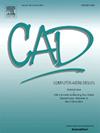关注CAD:基于Transformer的边界表示学习
IF 3.1
3区 计算机科学
Q2 COMPUTER SCIENCE, SOFTWARE ENGINEERING
引用次数: 0
摘要
最近,由Transformer网络驱动的生成式人工智能(AI)在自然语言处理、计算机视觉和图形学方面取得了显著的成功。然而,变形金刚在计算机辅助设计(CAD)中的应用,特别是在处理边界表示(B-rep)模型方面的应用,在很大程度上仍未得到探索。为了弥补这一差距,我们提出了一种新的方法,使变形器适应B-rep学习,称为边界表示变形器(BRT)。由于其不规则的拓扑结构和连续的几何定义,B-rep模型带来了独特的挑战,这与结构化和离散数据变压器设计的根本不同。为了解决这个问题,BRT提出了一种连续几何嵌入方法,该方法将B-rep表面(修剪过的和未修剪过的)编码为bsamzier三角形,在不离散的情况下保持其形状和连续性。此外,BRT采用拓扑感知嵌入方法,将这些几何嵌入组织成适合于变形金刚的离散标记序列,在B-rep模型中捕获几何和拓扑特征。这使得Transformer的注意力机制能够有效地学习B-rep模型中边界元素的形状模式和上下文语义。大量的实验表明,BRT在部分分类和特征识别任务中达到了最先进的性能。本文章由计算机程序翻译,如有差异,请以英文原文为准。
Bringing Attention to CAD: Boundary Representation Learning via Transformer
The recent rise of generative artificial intelligence (AI), powered by Transformer networks, has achieved remarkable success in natural language processing, computer vision, and graphics. However, the application of Transformers in computer-aided design (CAD), particularly for processing boundary representation (B-rep) models, remains largely unexplored. To bridge this gap, we propose a novel approach for adapting Transformers to B-rep learning, called the Boundary Representation Transformer (BRT). B-rep models pose unique challenges due to their irregular topology and continuous geometric definitions, which are fundamentally different from the structured and discrete data Transformers are designed for. To address this, BRT proposes a continuous geometric embedding method that encodes B-rep surfaces (trimmed and untrimmed) into Bézier triangles, preserving their shape and continuity without discretization. Additionally, BRT employs a topology-aware embedding method that organizes these geometric embeddings into a sequence of discrete tokens suitable for Transformers, capturing both geometric and topological characteristics within B-rep models. This enables the Transformer’s attention mechanism to effectively learn shape patterns and contextual semantics of boundary elements in a B-rep model. Extensive experiments demonstrate that BRT achieves state-of-the-art performance in part classification and feature recognition tasks.
求助全文
通过发布文献求助,成功后即可免费获取论文全文。
去求助
来源期刊

Computer-Aided Design
工程技术-计算机:软件工程
CiteScore
5.50
自引率
4.70%
发文量
117
审稿时长
4.2 months
期刊介绍:
Computer-Aided Design is a leading international journal that provides academia and industry with key papers on research and developments in the application of computers to design.
Computer-Aided Design invites papers reporting new research, as well as novel or particularly significant applications, within a wide range of topics, spanning all stages of design process from concept creation to manufacture and beyond.
 求助内容:
求助内容: 应助结果提醒方式:
应助结果提醒方式:


